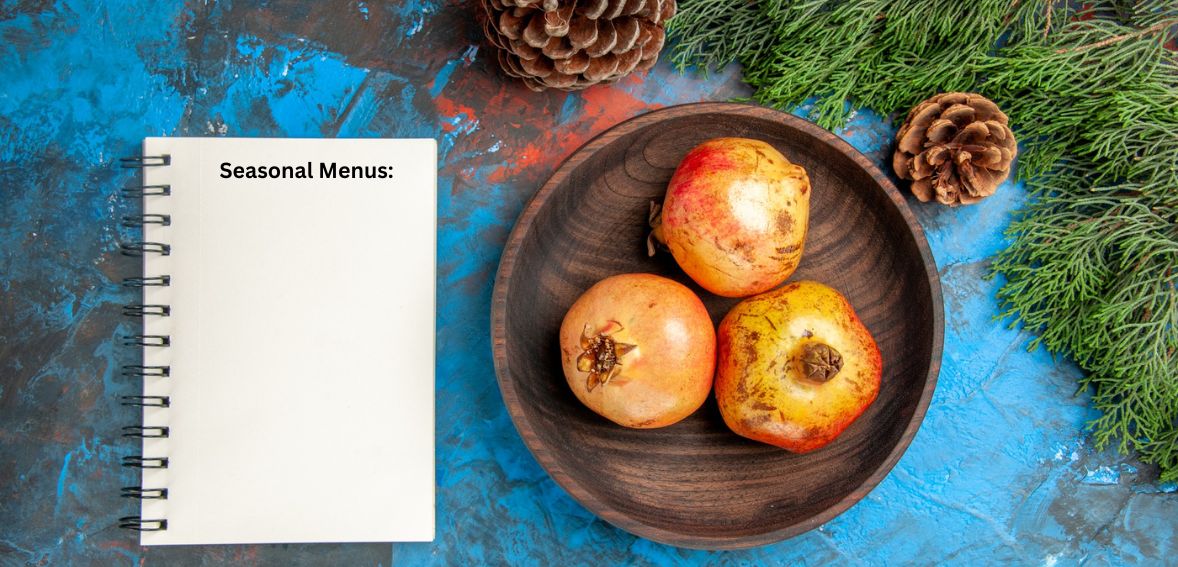
By exploremen August 28, 2025
Long-term success in the restaurant business depends on flexibility. Seasonal menus are one of the best ways to meet the freshness, creativity, and authenticity that today’s consumers demand. Restaurants can increase profitability by highlighting the best ingredients, creating excitement, and strengthening customer loyalty by updating their offerings in line with the seasons.
More than just changing out dishes once in a while, seasonal menus can help a brand establish its identity and build stronger relationships with customers. When done correctly, they connect the restaurant with the neighborhood, promote exploration, and use food to tell a story. They also help increase margins, streamlining supply chains, and reduce costs. In the end, adopting seasonal updates is a business strategy that fosters growth as well as a culinary decision.
The Appeal of Seasonal Menus for Customers

More than ever, diners are curious, informed, and concerned about their health. They prefer dishes that are presented and tasted in accordance with the season. A hearty, comforting stew in the winter feels very different from a spring dish full of vibrant herbs and fresh vegetables. Seasonal menus appeal to patrons because they seem timely, genuine, and pertinent to their experiences outside of the restaurant.
Seasonal offerings also appeal to the psychological energy of change. Similar to how people eagerly await seasonal customs like cool watermelon in the summer or pumpkin-spiced lattes in the fall, they also value it when restaurants follow those cycles in their menus. Menu updates give customers something fresh to look forward to, which promotes return business and word-of-mouth marketing.
That anticipation has the potential to be a strong loyalty motivator in a highly competitive industry. Furthermore, diners frequently equate quality with seasonal ingredients. Customers appreciate the fundamental vibrancy of fresh produce that is sourced at its peak. A menu that represents that caliber not only improves the dining experience but also conveys the restaurant’s attention to detail, thoughtfulness, and dedication to providing the best.
The Operational Advantages for Restaurants
From the perspective of the business, seasonal menus are more than a marketing tool—they make practical and financial sense. In-season ingredients are typically greater and less expensive. This enables eateries to create dishes with larger profit margins without sacrificing quality. For instance, tomatoes are the perfect focal point for summer menu items because they are more affordable and flavorful in the summer.
Restaurants can reduce waste by effectively rotating their stock through seasonal menu updates. Kitchens can concentrate on ingredients that are in season rather than stocking a wide variety of off-season items that might go bad or be underutilized. Time and money are saved by streamlining inventory management. Implementing tableside ordering benefits —like faster service and improved accuracy—can further enhance operational efficiency year-round.
Maintaining the creativity and engagement of the kitchen crew has operational benefits as well. Chefs have the chance to experiment, try out new methods, and work together on menu design when seasonal dishes are introduced. In addition to encouraging career advancement, this also contributes to the development of a positive kitchen culture, which results in improved execution and more creative cuisine.
Timing: When to Update Your Menu

Just as crucial as knowing what to put on a seasonal menu is knowing when to update it. Depending on the demand from customers and the availability of ingredients, some restaurants may change their menus more frequently than others, which follow the four main seasons of spring, summer, fall, and winter. Finding a rhythm that complements the local agricultural cycle and the restaurant’s concept is crucial.
A fine dining establishment might prefer quarterly updates to reflect more general seasonal themes, whereas a farm-to-table restaurant might alter its offerings monthly to showcase the freshest harvests. Casual restaurants, on the other hand, may take a hybrid strategy, introducing a few seasonal specials that change every few weeks while keeping a core menu of year-round favorites.
Customer behavior must also be taken into account when scheduling. During significant holidays or cultural events, diners frequently believe in seasonal changes, such as lighter spring fare after winter decadence or hearty winter fare. A restaurant can project an image of being progressive and attentive to the needs of its patrons by updating its menus a little before these changes occur.
Balancing Consistency and Innovation
Finding the perfect balance between adding new options and retaining customer favorites is one of the difficulties with seasonal menus. Every restaurant has staple dishes that patrons can count on to be served time and time again. Even if the new seasonal offerings are outstanding, eliminating these runs the risk of offending devoted customers.
Maintaining a solid base and adding seasonal innovation on top is the answer. While specials or limited-time dishes change with the seasons, core menu items can stay the same throughout the year. Customers will always be able to discover their favorites thanks to this balance, which also gives them motivation to try new flavors.
Seasonal variations should also complement the restaurant’s character. A Mediterranean bistro could highlight summer tomatoes and fresh herbs, while a seafood restaurant might highlight local oysters in the fall. By highlighting what makes the food genuine, timely, and relevant, the aim is to strengthen the brand rather than alter it with each season.
Marketing Seasonal Menu Updates

In addition to being a culinary choice, changing the menu seasonally offers a significant marketing advantage. Consumers like being informed about new products, and excitement about something new can create buzz. Storytelling about their food and ingredients is a common strategy used by restaurants to effectively promote seasonal updates.
Customers can be introduced to the larger food ecosystem, for example, by learning about the history of a nearby farm that provides fresh produce. Highlighting the source of a dish, be it a family recipe or a seasonal cultural custom, can also give the menu a more intimate feel. These stories strengthen the relationship between the restaurant and its customers while also improving the dining experience.
Here, too, digital platforms are essential. Websites, email newsletters, and social media can all be used to promote new dishes, advertise seasonal changes, and increase traffic. Using a reliable digital menu management software can make these updates seamless and efficient. Restaurants that combine appealing storytelling with expert food photography frequently have more success creating buzz and attracting reservations.
Seasonal Menus and Profitability
Profitability and seasonal menus have a clear but strong relationship. Restaurants can reduce food expenses without sacrificing quality by buying ingredients when they are most readily available. Higher sales volume may result from this margin increase, as well as the excitement of new dishes.
Additionally, seasonal cuisine offers a chance for premium pricing. For limited-edition products that highlight exclusivity, creativity, or freshness, customers are frequently willing to pay more. Positioning seasonal offerings as unique experiences rather than simple meals can increase perceived value and justify higher menu prices.
Additionally, new customers who are interested in the changes may be attracted by seasonal updates. Frequent diners might also come in more often to sample the newest dishes. These recurring business boosts long-term profitability and customer lifetime value.
Challenges and How to Overcome Them
Seasonal menus have obvious advantages, but there are drawbacks as well. The availability of ingredients can occasionally be unpredictable, particularly when supply chains are interrupted by inclement weather, logistical issues, or other outside influences. Restaurants need to be flexible with their seasonal planning and have backup plans in case some ingredients aren’t available.
Another difficulty is consistency. Depending on the harvest and source, seasonal ingredients can differ in size, flavor, or quality. This calls for educated kitchen workers who can modify recipes while upholding standards of quality even when circumstances change. Communication and staff training are also crucial.
In order to confidently explain new dishes and upsell them to customers, servers must be aware of seasonal changes. Execution of seasonal updates is ensured by clear coordination between front-of-house and back-of-house teams.
Building Community Through Seasonal Menus

The ability of seasonal menu changes to promote stronger community ties is perhaps one of their most underappreciated features. Restaurants establish a direct link between patrons and their environment when they highlight regional customs, artisanal producers, or local farmers. This boosts local economies and fosters a sense of community pride and loyalty.
Additionally, seasonal menus promote teamwork. Chefs can collaborate with bakeries, wineries, or breweries to produce special events or pairings. These partnerships increase the restaurant’s visibility in the neighborhood while also broadening the dining experience.
Restaurants support a larger culture of sustainability and community involvement by adopting seasonal updates. Modern consumers, who frequently want their dining choices to reflect their values, will find great resonance in this.
Conclusion
Seasonal menus are much more than just a culinary trend; they are a calculated tactic that helps businesses and consumers alike. Seasonal menu items provide diners with authenticity, diversity, and freshness while creating memorable experiences that are synchronized with the seasons. In addition to encouraging innovation and community involvement, they offer restaurants financial benefits in the form of cost savings, increased margins, and chances for premium pricing.
There are some difficulties in changing menus with the seasons, but they are far outnumbered by the advantages of careful preparation, adaptability, and effective communication. Finding a balance between innovation and consistency is crucial for giving loyal customers a sense of belonging while simultaneously encouraging them to come back and try new dishes.
In the end, a restaurant’s dedication to sustainability, quality, and patron satisfaction is reflected in its seasonal menu. It serves as a business tactic as well as an artistic medium, demonstrating to diners that food is changing, constantly changing, and deeply connected to the environment. In addition to maximizing profits, restaurants that adopt this dynamic approach stand to gain a lasting impression on their customers.